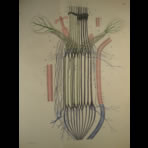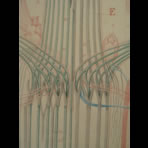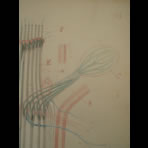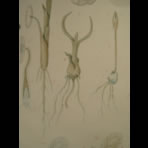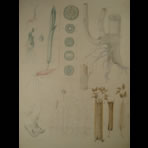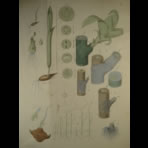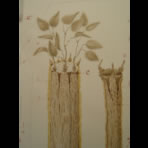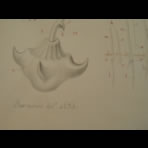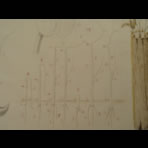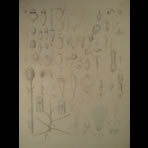Watercolors & Lithographs of Borromée click on the thumbnail to view full-size image
On the trail that leaves us Gaudichaud Beaupré.
This section of the Charles Gaudichaud Beaupré botanical cabinet, contains eighteen watercolors of the French painter and engraver "Borromée", held in 1838 to make way for the creation of the also eighteen hand-colored lithographs that will illustrate the book:
“RECHERCHES GENÉRALES SUR LA ORGANOGRAPHIE, LA PHYSIOLOGIE ET LA ORGANOGÉNIE DES VÉGÉTAUX”.
(General Research on the Organography, Physiology and Organogenesis of the plants), Paris by Fortin, Masson & Co., 1841. 1 In 4 soft cover volumes, Imprimerie Royale MDCCCXLI.
This very important scientific workbook which was awarded in the nineteenth century with the grand prize of the French Academy "Baron Montyon", (which is currently the Nobel Prize for scientific researches), is one of the most beautiful and important example ever printed for the study of botany of the nineteenth century, being the most impressive of this publication the watercolors as they were designed from the beginning of.
In this collection we can appreciate the personal notes and corrections for the ordering and reordering of the images done between the botanical artist Borromée and the wise Gaudichaud Beaupré, also differences and changes by comparing the originals followed by the lithographs published here, and today, when we have the opportunity to photograph images with macro lenses to publish them enlarged in this botanical Web site, means that we can appreciate the relevance and magnitude of this enormous work of scientific research at the vanguard of their time.
We can only admire and to ask us ¿how those personages could without the use of electronic microscopes or electricity, investigates and discovers the unimaginable for the time?
With these fine works of botanical art only remains for me to express my deepest respect for all those great men and women of knowledge who gave their lives to the secret world of the vegetable kingdom for the benefit of the Humanity.
Fernando Wamprechts.
Dimensions of all the watercolors: 9.01 X 12.06 inches.
Dimensions of all the color lithographs: 9.05 X 12.02 inches.
Dimensions of the lithograph with no color: 10.3 X 13.04 inches.
Siguiendo la pista que nos deja Gaudichaud Beaupré.
Esta sección del gabinete botánico de Charles Gaudichaud Beaupré conformado por dieciocho impresionantes acuarelas del pintor y grabador Francés “Borromée” realizadas en 1838 para dar paso a la creación de las también dieciocho litografías iluminadas a mano que ilustrarán el libro:
“RECHERCHES GENERALES SUR LA ORGANOGRAPHIE, LA PHYSIOLOGIE ET LA ORGANOGÉNIE DES VÉGÉTAUX”, (Investigaciones generales sobre la organografía, la fisiología y la organogenia de los vegetales), Paris by Fortin, Masson & Co., 1841. 1 volume softcover In 4., Imprimerie Royale MDCCCXLI.
Este importante libro galardonado en el siglo XIX con el gran premio “Barón de Montyon” de la academia francesa de ciencias, (equivalente al premio Nóbel para la investigación científica), es uno de los más hermosos e importantes ejemplares para el estudio de la botánica del siglo XIX.
Lo mas impresionante de esta publicación es en primer lugar el de poder tener la oportunidad de apreciar las acuarelas tal cual fueron creadas desde sus inicios así como
las notas corregidas para el ordenamiento y reordenamiento entre el artista botánico Borromée y el sabio Gaudichaud Beaupré, diferencias y cambios que se pueden apreciar al comparar el original seguido de la litografía que aquí publico, y hoy, en que tenemos la gran oportunidad de fotografiar imágenes para posteriormente publicarlas en este gabinete botánico, hace que podamos apreciar la importancia y magnitud de este inmenso trabajo de investigación científica a la vanguardia de su época.
No cabe más que admirar y volver a admirar para preguntarnos ¿como pudieron estos personajes sin el uso del microscopio electrónico ni electricidad, investigar y descubrir lo inimaginable para la época en beneficio de la humanidad?
Con estas láminas solo me queda expresar mi más profundo respeto por todos esos grandes hombres y mujeres de la ciencia y del arte que entregaron sus vidas al gran mundo secreto del reino de los vegetales.
Fernando Wamprechts.
Dimensiones de todas las acuarelas: 23 X 32 centímetros.
Dimensiones de todas las litografías a color: 24.05 X 31 centímetros.
Dimensiones de la litografía sin color: 26.05 X 34 centímetros.
Charles Gaudichaud Beaupré sailed on his second exploratory trip called La Herminie, (The Herminie) from the year 1830 to1832 visiting Brazil, Chile and Peru.
The Herminie returned to France in1832 and Gaudichaud remained in continuous researches, and in 1836-1837 he undertook a third voyage, circumnavigating the globe on La Bonite with Auguste Vaillant.
Back in Paris, wrote his famous notes about organographie, organogenesis and physiology of the plants, and presents his book at the Institute on 1 April 1835 for the contest of experimental physiology founded by Montyon.
His work, which shared the prize, is one of the most remarkable works and the most important one of the time.
Nissen 3233.
History of the Organography.
(Life Sciences & Allied Applications / Biology) the description of the organs and major structures of animals and plants.
Organographic, organographical adj
organographist n.
1-A description of the organs of animals or plants.
2-Scientific description of the organs of living things.
3-In biology, the study of organs and their relations; a description of the organs of plants and animals; descriptive organology.
4-The scientific description of the structure and function of the organs of living organisms.
Organography or organographies as a scientific study starts with Aristotle, who considered the parts of plants as "organs" and began to consider the relationship between different organs and different functions. In the 17th century Joachim Jung, clearly articulated that plants are composed of different organ types such as root, stem and leaf, and he went on to define these organ types on the basis of form and position.
In the following century Caspar Friedrich Wolff was able to follow the development of organs from the "growing points" or apical meristems. He noted the commonality of development between foliage leaves and floral leaves (e.g. petals) and wrote: "In the whole plant, whose parts we wonder at as being, at the first glance, so extraordinarily diverse, I finally perceive and recognize nothing beyond leaves and stem (for the root may be regarded as a stem). Consequently all parts of the plant, except the stem, are modified leaves."
Similar views were propounded at by Goethe in his well known treatise. He wrote: "The underlying relationship between the various external parts of the plant, such as the leaves, the calyx, the corolla, the stamens, which develop one after the other and, as it were, out of one another, has long been generally recognized by investigators, and has in fact been specially studied; and the operation by which one and the same organ presents itself to us in various forms has been termed Metamorphosis of Plants."
History of the physiology.
Physiology is the science of the function of living systems. It is a subcategory of biology.
In physiology, the scientific method is applied to determine how organisms, organ systems, organs, cells and biomolecules carry out the chemical or physical function that they have in a living system. The word physiology is from Ancient Greek: φύσις, physis, "nature, origin"; and -λογία, -logia, "study of".
History of the Physiology.
Is the science of the function of living systems. It is a subcategory of biology.
In physiology, the scientific method is applied to determine how organisms, organ systems, organs, cells and biomolecules carry out the chemical or physical function that they have in a living system. The word physiology is from Ancient Greek: φύσις, physis, "nature, origin"; and -λογία, -logia, "study of".
Human physiology dates back to at least 420 B.C. and the time of Hippocrates the father of medicine. The critical thinking of Aristotle and his emphasis on the relationship between structure and function marked the beginning of physiology in Ancient Greece, while Claudius Galenus (c. 126-199 A.D.), known as Galen, was the first to use experiments to probe the function of the body. Galen was the founder of experimental physiology. The ancient Indian books of Ayurveda, the Sushruta Samhita and Charaka Samhita, also had descriptions on human anatomy and physiology. The medical world moved on from Galenism only with the appearance of Andreas Vesalius and William Harvey.
During the Middle Ages, the ancient Greek and Indian medical traditions were further developed by Muslim physicians, most notably Avicenna (980-1037), who introduced experimentation and quantification into the study of physiology in The Canon of Medicine. Many of the ancient physiological doctrines were eventually discredited by Ibn al-Nafis (1213–1288), who was the first physician to correctly describe the anatomy of the heart, the coronary circulation, the structure of the lungs, and the pulmonary circulation, for which he is considered the father of circulatory physiology.[4][verification needed] He was also the first to describe the relationship between the lungs and the aeration of the blood, the cause of pulsation, and an early concept of capillary circulation.
Following from the middle Ages, the Renaissance brought an increase of physiological research in the Western world that triggered the modern study of anatomy and physiology. Andreas Vesalius was an author of one of the most influential books on human anatomy, De humani corporis fabrica. Vesalius is often referred to as the founder of modern human anatomy. Anatomist William Harvey described the circulatory system in the 17th century, demonstrating the fruitful combination of close observations and careful experiments to learn about the functions of the body, which was fundamental to the development of experimental physiology. Herman Boerhaave is sometimes referred to as a father of physiology due to his exemplary teaching in Leiden and textbook Institutiones medicae (1708).
In the 18th century, important works in this field were by Pierre Cabanis, a french doctor and physiologist.
In the 19th century, physiological knowledge began to accumulate at a rapid rate, particularly with the 1838 appearance of the Cell theory of Matthias Schleiden and Theodor Schwann. It radically stated that organisms are made up of units called cells. Claude Bernard's (1813–1878) further discoveries ultimately led to his concept of milieu interieur (internal environment), which would later be taken up and championed as "homeostasis" by American physiologist Walter Cannon (1871–1945).
In the 20th century, biologists also became interested in how organisms other than human beings function, eventually spawning the fields of comparative physiology and ecophysiology. Major figures in these fields include Knut Schmidt-Nielsen and George Bartholomew. Most recently, evolutionary physiology has become distinct sub disciplines.
The biological basis of the study of physiology, integration refers to the overlap of many functions of the systems of the human body, as well as its accompanied form. It is achieved through communication which occurs in a variety of ways, both electrical and chemical.
In terms of the human body, the endocrine and nervous systems play major roles in the reception and transmission of signals which integrate function. Homeostasis is a major aspect with regards to the interactions within an organism, humans included.
History of the Organogenesis. (Organogénie).
The process of formation of specific organs in a plant or animal involving morphogenesis and differentiations.
[ Organo- + genesis .] 1. (Biol.) The origin and development of organs in animals and plants. 2. (Biol.) The germ history of the organs and systems of organs, -- a branch of morphogeny. Haeckel
Plant growth
Further information: Meristem, Cellular differentiation, Morphogenesis, and Plant embryogenesis
A vascular plant begins from a single celled zygote, formed by fertilisation of an egg cell by a sperm cell. From that point, it begins to divide to form a plant embryo through the process of embryogenesis. As this happens, the resulting cells will organize so that one end becomes the first root, while the other end forms the tip of the shoot. In seed plants, the embryo will develop one or more "seed leaves" (cotyledons). By the end of embryogenesis, the young plant will have all the parts necessary to begin in its life.
Once the embryo germinates from its seed or parent plant, it begins to produce additional organs (leaves, stems, and roots) through the process of organogenesis. New roots grow from root meristems located at the tip of the root, and new stems and leaves grow from shoot meristems located at the tip of the shoot. Branching occurs when small clumps of cells left behind by the meristem, and which have not yet undergone cellular differentiation to form a specialized tissue, begin to grow as the tip of a new root or shoot. Growth from any such meristem at the tip of a root or shoot is termed primary growth and results in the lengthening of that root or shoot. Secondary growth results in widening of a root or shoot from divisions of cells in a cambium.
In addition to growth by cell division, a plant may grow through cell elongation. This occurs when individual cells or groups of cells grow longer. Not all plant cells will grow to the same length. When cells on one side of a stem grow longer and faster than cells on the other side, the stem will bend to the side of the slower growing cells as a result. This directional growth can occur via a plant's response to a particular stimulus, such as light (phototropism), gravity (gravitropism), water, (hydrotropism), and physical contact (thigmotropism).
F. Wamprechts.
ABBREVIATION FOR BOTANISTS.
Pier Antonio Micheli (December 11, 1679 - January 1, 1737): Micheli
Christian Hendrik Persoon (February 1, 1761 – November 16, 1836): Pers
Jean Baptiste François Pierre Bulliard: (1742 – 26 September 1793): Bull. Bulliardi.
Carl von Linné (May 23, 1707 – January 10, 1778): L.
Carl von Linné or Carolus (January 20, 1741 – November 1, 1738): L.f.
Peter Olof Swartz (September 21, 1760 – September 19, 1818): Sw.
James Edward Smith (December 2, 1759 – March 17, 1828): Sm.
Robert Brown (December 21, 1773 – June 10, 1858): R.Br.
Adolphe Théodore Brongniart (January 14, 1801 – February 18, 1876): Al. Brong. or Brong.
Nicaise Augustin Desvaux (1784 – 1856): Desv.
Georg Eberhard Rumphius (1628 – 1702): Rumph.
Antoine Laurent de Jussieu (April 12, 1748 – September 17, 1836): Juss.
Philibert Commerçon 18 de November (18, 1727 – March 13, 1773): Comm.
Louis Marie Aubert Du Petit-Thouars ou Du Petit Thouars (November 5, 1758 – May 12, 1831): Thouars.
Carl Ludwig Willdenow (August 22, 1765 – July 10, 1812): Willd.
Johann Reinhold Forster (October 22, 1729 – Dezember 9, 1798): J.R.Forst.
Alexandre Henri Gabriel, vicomte de Cassini (1781 – 1832): Cass.
Jacques-Julien Houtou de La Billardière, (October 28, 1755 – January 8, 1834): Labill.
Achille Richard (April 27, 1794 – October 5 1852): A.Rich.
Augustin Pyrame de Candolle (February 4, 1778 – September 9, 1841): DC.
Karl Sigismund Kunth (Jun 18, 1788 –March 22, 1850): Kunth.
Hipólito Ruiz López (1752 – 1816): Ruiz & Pavon.
Jose Antonio Pavón y Jimenez (1754 – 1840): Ruiz & Pavon.
Karl (ó Carl) Friedrich von Gärtner (May 1, 1772 – September 1 1850): C.F.Gaertn.
Joseph Gaertner, or Joseph Gärtner (March 12, 1732 – July 12, 1791): Gaertn.
Gaudichaud-Beaupré (September 4, 1789 – January 16, 1854): Gaudich.
BORROMÉE.
Referred to in the book: DIE BOTANISCHE BUCHILLUSTRATION.
Claus Nissen.
Page 19 BAND II BIBLIOGRAPHIE :
190. Boissier, Edmond Pierre. Voyage dans le midi de l´Espagne pendant l´anne 1837. Paris : Gide 1839-45, 4º. 2 bde. 22 Fasc. Und Atlas mit 208 Kupf. I-181, Ia, 4a, 6a, 9a, 14a, 14b, 26a, 40a, 64a, 80a, 84a, 85a, 92a, 98a, 102a, 108a, 113a, 118a, 122a, 123a, 125a, 126a, 132a, ferner doppelt: 92, 98, 115.
Z.:Heyland: A Riocrieux.- St.: BORROMÉE; Heyland.
Pag : 21. BAND II BIBLIOGRAPHIE:
213. Nouvelle Flore du Péloponnèse et des Cyclades, entièrement revue, corrigée et augmentée par Chaubard pour les phanérogames et Bory de Saint-Vincent pour les cryptogames, les agames, les considérations générales, la distribution des espèces par familles naturelles et ce qui a rapport aux habitat.
Paris u. Strassbourg : Levrault 1838. 2º 4 Lfgen. 8, 87 S., 42 Taf. (Kupf., Nr. 42: Lith.).
Z.: Bory de Saint Vincent; BORROMÉE; Ad. Brocq; Chaubard; E. Delile.
St.: Breton; G Coignet; Duménil; Francois; Georger; E. Taillant; Ambr. Tardieu.-Dr. : Langlois.- Lith. : C Adrien.
1.- Aug. In : expédition scientifique de Morée. Sect. Des sciences physiques. Vol. 3, II : Botanique. Paris 1832 (-36). Mit 38 Kupf.
Pag. 53. BAND II BIBLIOGRAPHIE:
556. Voyage au Pôle Sud et dans l´Oceanie sur les corvettes LÁstrolabe et la Zélée, exécute pendant les annes 1837-40. Paris 1841 bis 54.- Botanique. Par Hombron et Jaquinot. 1845-53. 4º 2 Bde. und Atlas 1852. 2º. Mit 66 Kupf.
Z. : BORROMÉE: Gonthier ; Oudart ; Alfr. Riocreux. St. : Coupé ; A. Duménil ; Mlle. Mégissier ; A. Pérée ; Ve. Schmelz ; Taillant ; J. Thomas ; Visto.
Dr. Bougeard.
Über die Erscheinungsdaten s. Sherbon & Woodward in: Ann. Mag. Nat. Hist. (7), 1901 S. 390* u. 8, 1901, S. 494.
Pag. 65 BAND II BIBLIOGRAPHIE:
CHARLES GAUDICHAUD BEAUPRÉ.
Angouleme 4-9-1789--16-I-1864, Paris, Pharmacien de la marine (Ch. Berger u. H Rey : Répertoire bibliographique des travaux des médecins et pharmaciens de la marine française, 1874. S. III).
688. Recherches générales sur la organographie, la physiologie et l´organogénie des végétaux.
Paris impr. Royale 1841. 2º. 130 S., 18 Lith. (Stahlstiche ?).
Z. : BORROMÉE (del. Et dir.).
*Pag. 65 BAND II BIBLIOGRAPHIE*. JOURNEY OF LA BONITE.
690. Voyage Autour du Monde, exécuté pendant les années 1836 et 1837 sur la corvette La Bonite commandé par M. Vaillant- Botanique. Paris (1844-) (1846-66. 8º. Bde. Und Atlas (1846-49). 2º mit 150 (156 ?) Kupf.
ZEICHNER : BORROMÉE, Gontier ; Himeli ; Périaux ; Riocreux ; Vauthier.
St : Annedouche ; Baron ; Mlle Coutellot ; Davesne ; Dumçenil ; Forget; Giraud; Mme Gouflé Noriot; Guyard; Lebrun; Manceau; Mlle Massard; Mougeot; Mlle Noiret; Martin Schmelz; Sebin; Spelette; Teillard; J. Thomas ; Victor ; Visto.
Dr. Bougeard.
• Erscheinungsdaten s. Sherborn & Woodward a.a. O.
• Die Originale in Paris, Muséum d´hist. Nat.
Pag. 89 BAND II BIBLIOGRAPHIE.
Jacquemont, Victor.
Paris 8.8.1801--7.12.1832 Bombay (P. Maes: Un ami de Stendhal. Paris 1934. 642 S. 12 Taf).
966. Voyage dans l´Inde pendant les années 1828-32. Publié sous les auspices de M. Guizot.
Paris (1835-) 1841-44. 4º. Und Atlas.
2 Bde. Mit 4 Kt. U 290 Taf. (83, 207, davon 180 botanishe).
Zeichner: E. Delile (del.et. direx); Ariocreux. Ferner; BORROMÉE.
Über die Erscheinungsdaten s. Sherborn & Woodward in: Ann, Mag. Nat. Hist. (7) 8, 1901, S. 334-
Pag. 174 BAND II BIBLIOGRAPHIE:
Spach, Edouard.
Strassburg 26. 11. 1801—18. 5. 1879 Paris (Bureau in: Bull. Soc. Bot. France 26. 1879, S. 194-196: Ed. Bonnet: Notice sur la vie et les travaux de E. Sp.1879, auch in Le Nauraliste I, 1879/80, S. 38-40.
1878 Histoire des végétaux : Phanérogames. Paris 1834-48. 8º. 14 Bde u. Atlas.
72 S., 152 Kupf.
Z.:J. Decaisne; Mlle F. Legendre; Mme Spach.- St. : Borromée (dir.) : Breton ; Davesne ; Mlle Dondey ; Le Couturier ; Mougeot ; Mlle Dondey ; Mlle Noiret ; F. Plée. S.A. Boot, Fr. ; Jaubert, Hipp. Fr. de
Pag. 213 BAND II BIBLIOGRAPHIE:
2246 Exploration scientifique de l´Algérie pendant les annés 1840-42. Paris 1844-67.-Botanique.
T. I : Flore d´Algérie, Cryptogamie, par Durieu de Maisonneuve. Paris : Impr. Royale 1846-49 (-69). II, 631 S.
T.2 : Flore d´Algérie. Phanerogamie. Groupe des Glumacées. Par Ernest Cosson et Durieu de Maisonneuve. 1854 (d. i. 1855-) 1867 (-68). 3 Pts. CIV, 330 S.
Atlas de la flore de Algérie, ou illustrations d´un nombre de plantes nouvelles ou rare de ce pays. (1846-49) 1850.
II, 39, 7 S., 90 kol. Kupf. (I-90, 22 bis 45 bis, dafür fehlen Nr. 57 u. 70)
Zeichnern: Vaillant.- St.: BORROMÉE (sculp. Et col.) : Ferner ; Annedouche ; Clergé ; Corbié ; Forget ; Giraud ; P. Picart ; Schmelz ; Sebin ; J. Thomas.- Dr.. Bougeard ; Chardon aîné & Aze (I).
Über die erscheinungsdaten s. Sherborn & Woodward in: Ann. Mag. Nat. Hist. (7) 8, 1901, S. 162.
KÜNSTLER BORROMÉE (z, St, Kol) Paris 1828-50 > 148; 190, 213, 461, 556, 688, 690, 966, 1878, 2009, 2245, 2246.









